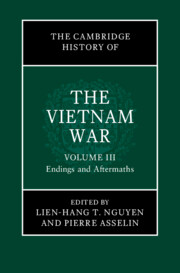Book contents
- The Cambridge History of the Vietnam War
- The Cambridge History of the Vietnam War
- The Cambridge History of the Vietnam War
- Copyright page
- Contents
- Figures
- Maps
- Contributors to Volume III
- General Introduction
- Introduction
- Part I The Late Vietnam War
- 1 Nixon’s War
- 2 US Military Strategy in the Nixon Era
- 3 The US Congress and the Vietnam War
- 4 US Antiwar Sentiment and International Relationships in the Late Vietnam War
- 5 Saigon War Politics, 1968–1975
- 6 Hanoi’s Politburo at War, 1969–1975
- 7 The Vietnam War and the Regional Context
- 8 Moscow, Beijing, and Détente
- 9 The Easter Offensive and the Second Air War
- 10 The Second Civil War, 1973–1975
- 11 Cambodia at War
- 12 Laos at War
- Part II The Postwar Era
- Part III Legacies
- Index
6 - Hanoi’s Politburo at War, 1969–1975
from Part I - The Late Vietnam War
Published online by Cambridge University Press: 02 January 2025
- The Cambridge History of the Vietnam War
- The Cambridge History of the Vietnam War
- The Cambridge History of the Vietnam War
- Copyright page
- Contents
- Figures
- Maps
- Contributors to Volume III
- General Introduction
- Introduction
- Part I The Late Vietnam War
- 1 Nixon’s War
- 2 US Military Strategy in the Nixon Era
- 3 The US Congress and the Vietnam War
- 4 US Antiwar Sentiment and International Relationships in the Late Vietnam War
- 5 Saigon War Politics, 1968–1975
- 6 Hanoi’s Politburo at War, 1969–1975
- 7 The Vietnam War and the Regional Context
- 8 Moscow, Beijing, and Détente
- 9 The Easter Offensive and the Second Air War
- 10 The Second Civil War, 1973–1975
- 11 Cambodia at War
- 12 Laos at War
- Part II The Postwar Era
- Part III Legacies
- Index
Summary
The Vietnamese communist leadership displayed a remarkable degree of ingenuity and resourcefulness in its quest to drive out the Americans, finish off the regime in Saigon, and win the conflict by achieving national reunification under its exclusive aegis. At times, it proved callous to the extreme, making choices it understood might result in massive death and suffering for its people. Increasingly reliant over time upon military and other aid from socialist allies, most notably China and the Soviet Union, it still jealously guarded its autonomy, refusing even to consult those allies about major strategic matters. The audacity and temerity of the Hanoi Politburo were matched only by its impenetrability and staunchness. In the end, it prevailed over its enemies owing less to their shortcomings than to the merits of its masterfully crafted and carefully calibrated strategy of “struggle” on three separate yet closely intertwined fronts.
Keywords
- Type
- Chapter
- Information
- The Cambridge History of the Vietnam War , pp. 141 - 162Publisher: Cambridge University PressPrint publication year: 2024

